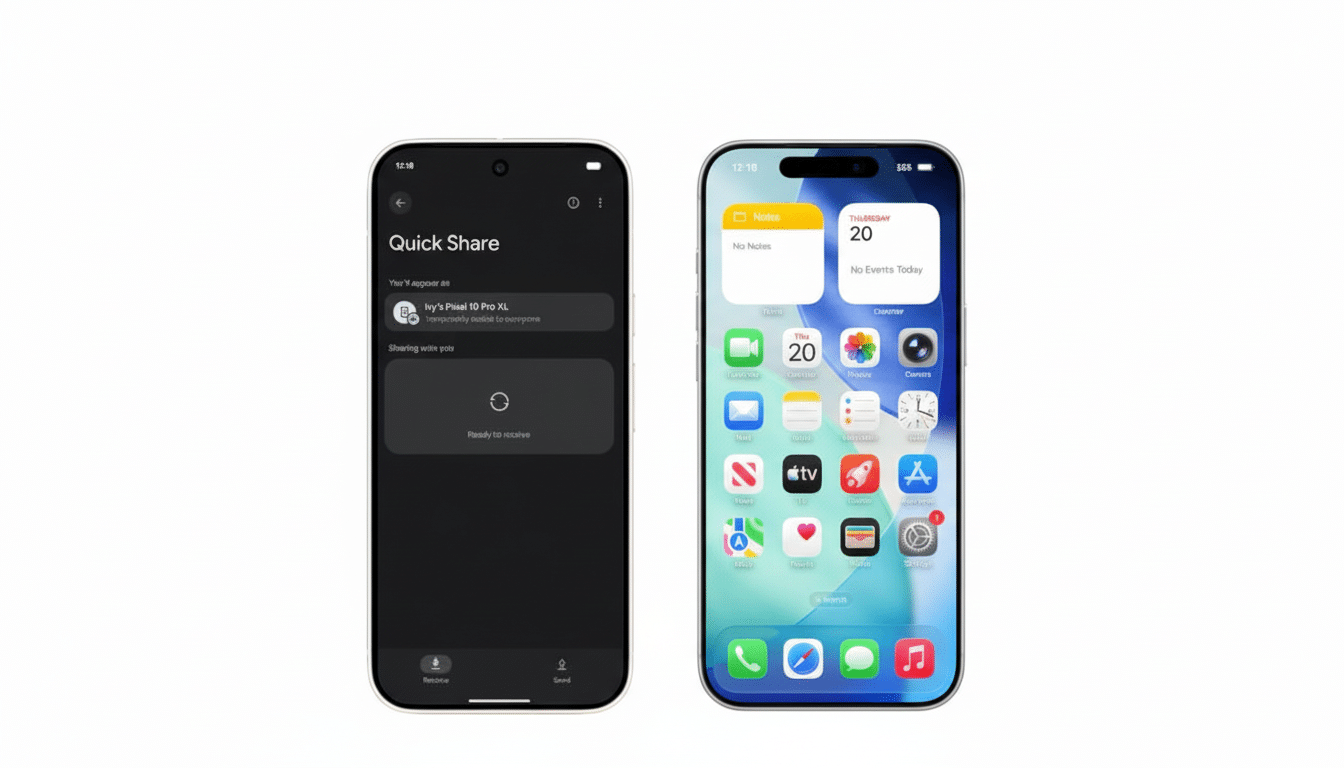Google just went ahead and did what most of us assumed was years away: Pixel 10 owners can now AirDrop files over to iPhones, iPads, or Macs using Quick Share with no workarounds.
It’s a gutsy interoperability play that ends up working pretty smoothly after both devices go to “Everyone for 10 minutes.” It really does feel like a breakthrough for cross-platform sharing — and yet, three big questions hang over what’s next.

Can Apple Pull the Plug on Cross‑Platform AirDrop?
The immediate question isn’t whether the feature functions, because it does, but how Apple reacts. AirDrop operates on Apple’s own AWDL (pronounced “audible”) networking stack, and it relies on Bluetooth Low Energy for discovery and a direct Wi‑Fi connection for the payload. If Google is effectively handshaking with AirDrop when devices are set to “Everyone for 10 minutes,” Apple might change the pairing flow, do more-aggressive key rotation, or tweak packet formats in a standard iOS/macOS update. That could close the door without a public showdown.
Politically, that’s tricky. In Brussels, interoperability has become a live issue under the Digital Markets Act and both sides of the Atlantic are looking into technology lock-in. A harsh block faces the possibility of more anti-competitive allegations at a time when Apple is already fielding criticisms of messaging standards, browser engines, and app distribution. But sitting on our hands just gives Google the optics advantage, as now it can say that it is taking friction out from between platforms.
The stakes are high. IDC’s most recent figures peg Apple and Samsung at approximately 20%–21% share of total smartphone shipments worldwide, while Android OEMs in aggregate control the rest. If even a fraction of the newly occurring daily sharing stays off cloud links and heads into AirDrop-grade local transfers directly between Android and iOS, user expectations will change — and Apple will be forced to take its foot off of the cat-and-mouse gas pedal long enough to settle some rules for third-party players instead of playing whack-a-mole.
Rollout Realities Across Android Devices and OEMs
Currently, the interoperability is apparently limited to the Pixel 10 and offered by a Quick Share extension updated via Google Play services. That’s smart distribution: Play services is Google’s field-update mechanism for the majority of Android devices. But broadening support isn’t trivial. With Android, the hardware is so diverse — from chipsets and radios to vendor stacks and embedded software-based Bluetooth/Wi‑Fi firmware idiosyncrasies. Frictionless peer-to-peer transfers require intimate collaboration between BLE discovery, Wi‑Fi channels, and power management — a perfect storm for Android fragmentation to wreak havoc.
There’s also branding and UX confusion there. Google combined “Nearby Share” and Samsung’s “Quick Share” earlier this year to eliminate confusion, but integrating with AirDrop introduces new edge cases: which picker shows up, how devices are prioritized, how failures are communicated, and what happens — especially on iOS — when one side isn’t in the right visibility state. If the feature remains exclusive to Pixel for long, it could become a headline feature that many Android users can’t copy — and a support headache as friends expect it to “just work.”
Enterprises add another wrinkle. A lot of organizations lock down AirDrop in iOS via management profiles to protect against data loss. Android device policy controls would also need to grow so IT can enable on-network Quick Share but disallow ad‑hoc cross‑platform discovery where necessary. Without listings of admin levers and audit trails, the feature is likely to be blocked in precisely the domains where fast local transfers would yield the biggest time savings.

Security and Privacy Trade-offs in Cross‑Platform Sharing
AirDrop has a lineage of security — but a tainted one.
AirDrop’s contact discovery phase could inadvertently reveal hashed phone numbers and emails under certain circumstances, academic work from TU Darmstadt in 2021 showed. Apple’s made the behavior harder to predict over time, but the lesson remains: proximity sharing protocols are nuanced and even small missteps can lead to metadata leaks or spoofing windows.
It appears that Google is depending on users enabling “Everyone for 10 minutes” on each device. That user action is clever from a safety angle, curtailing drive‑by spam and repeating Apple’s harassment countermeasures. Still, toggling discoverability opens up the attack surface, if only for a moment. If third-party developers begin using this trick, we might wind up with uneven levels of cryptographic verification, sender identity validation, and on-device scanning. But the threat isn’t just malicious files; it’s social engineering of cute device names, preview thumbnails, and spoofed avatars in filled VR lobbies.
Transparency will be vital. Users need to have knowledge of what protocol is in use, how identities are authenticated, what metadata gets transferred, and where the data sit. Security researchers will desire reproducible test cases and bug bounty coverage. Regulators are going to want to know how the feature aligns with privacy regimes like GDPR when contact discovery crosses ecosystems. And if Google wants this to be a thing beyond Pixel 10, it requires an actual technical note and predictable security lifecycle — not just a neat proof of concept.
Why This Move Still Matters for Everyday File Sharing
But despite those fears, the potential upside is clear. Neighborhood, high‑bandwidth exchanges beat cloud detours for 4K video, RAW photo bursts, and app bundles — and they can happen even without reception. For those with mixed Android and iOS households and classrooms, this marks the first time that “send me that quickly” doesn’t filter through chat downloads or USB cables. If Google can beef up the security story, shut down the UX, and get past the Apple question entirely, this might reset just what people expect from devices that share across the aisle.
In brief, it is bold and belated. But its success depends on three things:
- Whether Apple stands back or adjusts
- Whether Google can scale beyond Pixel without fragmentation fallout
- Whether the privacy model wins trust
Hit those, and cross‑platform AirDrop is no longer a headline; it’s just there.

